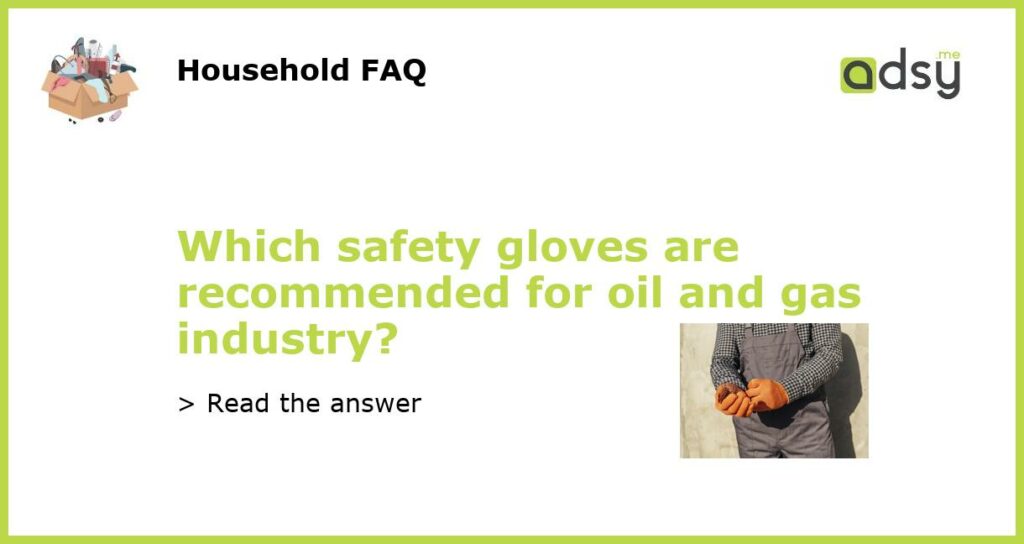The oil and gas industry can be a hazardous environment to work in. With potential risks such as chemical exposure, cuts, burns, and abrasions, it is essential to prioritize safety measures. Safety gloves play a crucial role in protecting workers’ hands and preventing accidents or injuries. However, not all gloves are suitable for the unique challenges of the oil and gas industry. In this article, we will explore the recommended safety gloves for this industry.
Factors to Consider
Before diving into specific glove recommendations, it is important to understand the key factors to consider when selecting safety gloves for the oil and gas industry.
- Chemical Resistance: The oil and gas industry involves working with various chemicals, such as acids, solvents, and oils. Gloves with high chemical resistance are essential to protect against chemical exposure.
- Flame and Heat Protection: Working in the oil and gas industry often involves proximity to open flames and high temperatures. Gloves with flame-resistant materials or insulation provide protection against burns.
- Cut and Puncture Resistance: Sharp objects, jagged edges, and equipment with moving parts pose risks for cuts and punctures. Gloves with high cut and puncture resistance can help reduce these risks.
- Grip and Dexterity: Handling tools, equipment, and slippery surfaces require gloves with a good grip and dexterity to maintain control and prevent accidents.
- Comfort: Workers in the oil and gas industry often wear gloves for extended periods. Comfortable gloves can enhance productivity and reduce hand fatigue.
Recommended Gloves
Based on the above factors, here are some recommended safety gloves for the oil and gas industry:
Nitrile Gloves
Nitrile gloves are a popular choice in the oil and gas industry due to their excellent resistance to chemicals, oils, and solvents. They provide protection against punctures, cuts, and abrasions, making them suitable for handling sharp objects. Nitrile gloves also offer good grip and dexterity, allowing workers to manipulate tools and equipment with ease. Additionally, they have low allergenicity and do not contain latex, making them suitable for workers with latex allergies.
Cut-Resistant Gloves
Cut-resistant gloves are essential for tasks involving sharp objects and machinery. The oil and gas industry often includes activities like handling metal pipes, cutting wires, or operating heavy machinery. Gloves made with high-performance materials such as Dyneema, Kevlar, or stainless steel offer exceptional cut resistance. Look for gloves with ANSI (American National Standards Institute) cut levels that meet the required protection for the specific task.
Headline 6: Flame-Resistant Gloves
Flame-resistant gloves are necessary for workers exposed to open flames, sparks, or high temperatures. These gloves are made from materials such as Nomex, Kevlar, or leather, which provide excellent heat resistance. Flame-resistant gloves not only protect against burns but also offer durability and good grip for handling tools and materials in high-heat environments.
Headline 7: Impact-Resistant Gloves
Impact-resistant gloves are designed to protect against crushing, impact, and vibration hazards. In the oil and gas industry, workers may encounter heavy equipment, machinery, or tools that can cause hand injuries. Gloves with built-in padding or impact-absorbing materials, such as thermoplastic rubber (TPR), provide the necessary protection. These gloves also offer good grip and dexterity to prevent slippage and maintain control.
Headline 8: Glove Standards and Testing
When selecting safety gloves for the oil and gas industry, it is crucial to consider industry standards and testing certifications. Look for gloves that meet or exceed the requirements set by regulatory bodies, such as the Occupational Safety and Health Administration (OSHA) and the American Society for Testing and Materials (ASTM). These standards ensure that the gloves have undergone rigorous testing for factors like chemical permeation resistance, cut resistance, and flame resistance.
Headline 9: Conclusion
Choosing the right safety gloves for the oil and gas industry is vital to protect workers from potential hazards. Consider factors such as chemical resistance, flame and heat protection, cut and puncture resistance, grip and dexterity, and comfort when selecting gloves. Nitrile gloves, cut-resistant gloves, flame-resistant gloves, and impact-resistant gloves are some recommended options. Ensure that the gloves meet industry standards and certifications for optimal protection. Prioritizing safety by providing the right gloves will contribute to a safer work environment for oil and gas industry workers.






